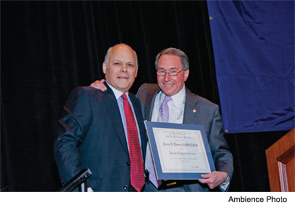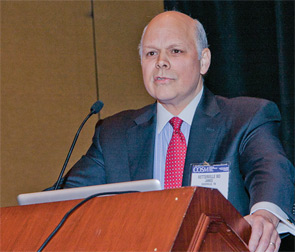
Explore This Issue
May 2012A medical career is a career in discovery, and keys to that discovery are listening carefully to patients, surrounding yourself with intelligent people, and not letting mysteries lie unsolved, said James Netterville, MD, director of head and neck surgery at the Vanderbilt-Ingram Cancer Center and the Joseph H. Ogura, MD, Lecturer at the 115th Annual Meeting of the Triological Society, held here on April 20 as part of the Combined Otolaryngology Spring Meetings.
Dr. Netterville talked about his experiences and the medical knowledge that has stemmed from his handling of carotid body tumors. “Tumors will teach you a great deal if you observe them and if you listen to them,” he said.
Early Errors
It’s a journey that started off with moments that Dr. Netterville said he now wishes he could undo.
In the late 1980s, over the course of just a few months, he removed carotid body tumors from three sisters, for whom he had been camp counselor nearly 20 years earlier when they were still young girls. At the time, the standard thinking about the tumors was that they needed to be removed. After their surgeries all of the sisters experienced wild fluctuations in blood pressure, with no apparent cause. For one of the sisters, the consequence was even more serious. The woman had a carotid body tumor, which, without question, needed to be removed.
“But,” Dr. Netterville said, “right above was a 1 centimeter vagal paraganglioma. I would love to put that tumor back, but I took it out because it was there. Cost her her vagus nerve that day.”
The blood pressure swings were “impairing their life,” he said. “I’m supposed to make these three young ladies better.”
In addition, the girls had trouble eating, saying they had a severe pain in the jaw that went away after a few bites. The same condition arose in other relatives of the sisters. And the blood pressure swings didn’t respond to medication. But the difficulties led to revelations.
Discoveries
After multiple consults, David Robertson, MD, director of Vanderbilt’s Clinical Research Center, began to put together the pieces. He found the patients had a failure of the baroreflexes, in which short-term changes in blood pressure are buffered when the stretching of blood vessels caused by increased pressure prompts a counter-response in the vessel walls.
Dr. Robertson led a study on the diagnosis and treatment of baroreflex failure based on Dr. Netterville’s patients that ran in the New England Journal of Medicine (1993;329(20):1449-1455). Dr. Netterville is an author on the study, and the experience led him to specialize in the management of carotid body tumors.

—James Netterville, MD
Observational Lessons
Dr. Netterville has followed 43 patients for five years and admitted that this is too short a time for definitive results, especially in patients who were merely observed.
After five years, 42 percent had no change in tumor size, 38 percent had an increase in size of 2 mm per year and went on to resection, and some were found to have had small regressions in tumor size, though that could have been caused by irregularities stemming from how the scans were read.
Dr. Netterville noted the huge change in the approach to carotid body tumors from then to now. “When I started this, a paraganglioma was an evil, mean, bloody tumor latched on the carotid artery that has to come out tomorrow before it leads to death or causes a stroke,” he said. “But what do we really know? These are not urgent procedures at all. These are very slowly growing tumors that we can choose to observe for long periods of time…. Eventually you might operate on it. Maybe they won’t need it.”
In some cases, though, removal is the only good option, he said, noting the case of a man for whom no resection was done and who nearly died from amyloidosis.
For all the knowledge he gained through the years, Dr. Netterville still heard complaints about that pain that patients were having when they took their first bites of food. It was described as “spasm-like” in the area of the parotid glands after the first bite of a meal, with the severity increasing with the interval between oral intakes and the potency of the salivary stimulus.
Finally, Dr. Netterville saw a 13-year-old who’d been playing with his father’s pistol and suffered a gunshot wound to the right maxillary sinus. The internal carotid artery was occluded at the entry to the skull. He also had Horner’s syndrome.
It was decided that the bullet didn’t need to be removed. Six months later, he came back with apparently no new problems—except, after a 20-minute conversation, his mother mentioned her son having pain at the first bite of a meal.
This prompted Dr. Netterville to start thinking about sympathetic nerve damage and a link to carotid body tumor resections, in which all the post-ganglionic sympathetic fibers are stripped away.
In the parotid gland, the sympathetic nerves innervate the myoepithelial muscle, which squeezes out saliva. If this is lost, Dr. Netterville has postulated, the cell undergoes a “post-innervation supersensitivity.”
“My theory is that it’s all the myoepithelial muscles spasming at one time when you eat,” he said. Then the pain subsides as the receptors become saturated. It’s the subject of a paper that has been sitting on his desk for two decades. He has found a lot of skeptics, but no publisher.
His experience with these patients “ended up handing me and putting in my lab tremendous numbers of patients with cranial neuropathies,” Dr. Netterville said.
Unexpected Course
Dr. Netterville said it’s impossible to know where your medical career will take you. “You can’t sit here and plan, ‘This is what I’m going to be known for. This is what I’m going to accomplish,’” he said. “All you can do is seize opportunity and hang around with smart people. And they’ll open doors for you.”
Robert Ossoff, MD, President of the Triological Society, told the audience after the speech that they’d hope they’d enjoyed the lessons of a storyteller. “Jim has a unique way of teaching,” Dr. Ossoff said. “I think most of us lecture—Jim tells a story, and through the story comes out the teaching, the learning.”
Leave a Reply